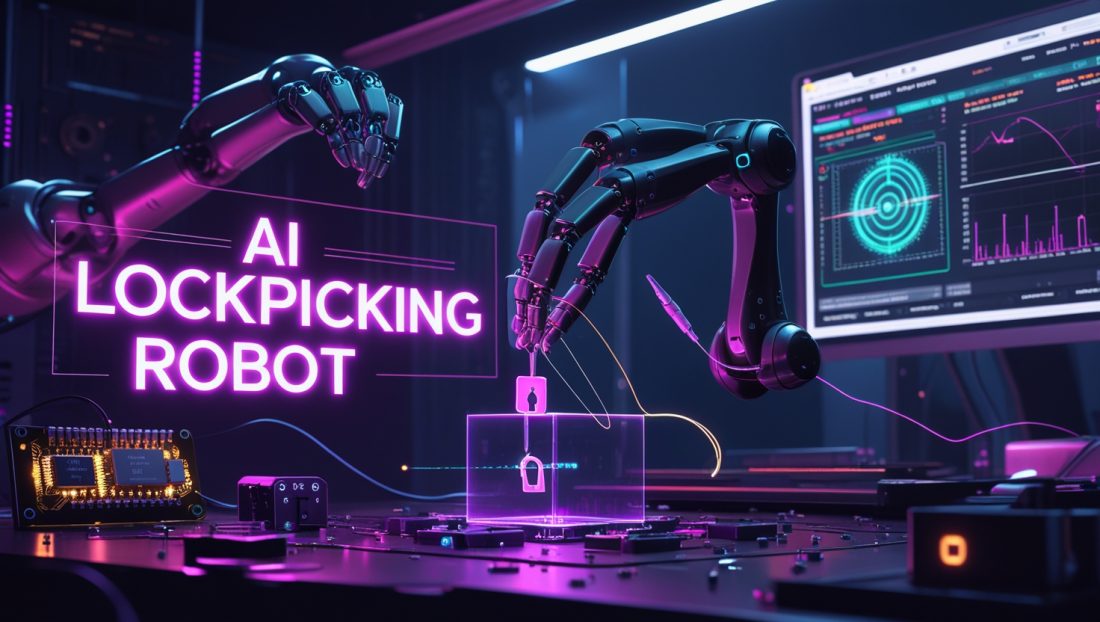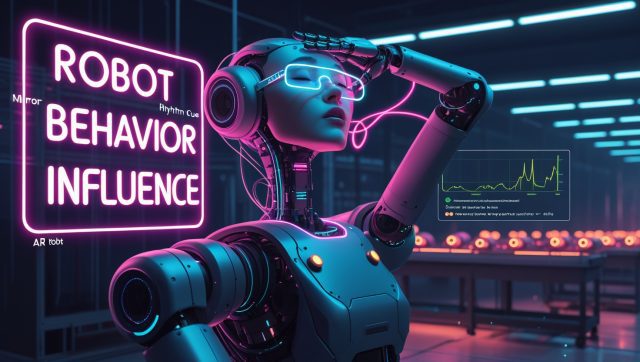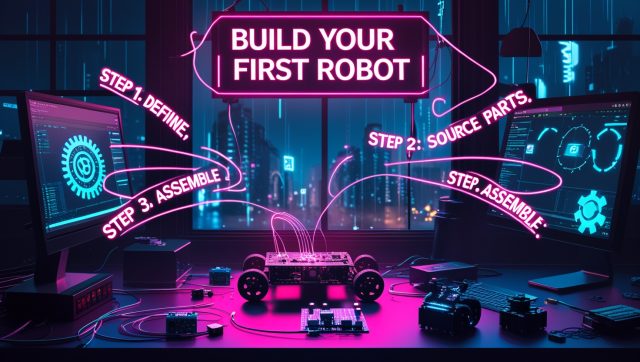Breakthrough in Physical Security Automation
On July 21, 2025, YouTube creator Sparks and Code unveiled the world’s first functional AI lockpicking robot capable of sensing individual lock pins—a transformative leap in physical security automation. This revolutionary machine combines thin force-sensitive wires, machine learning algorithms, and precision mechanics to manipulate pin-tumbler locks with human-like sensitivity. Unlike previous brute-force robots, this innovation processes real-time tactile feedback to detect binding pins and security mechanisms, potentially reshaping security testing and lock manufacturing industries. The development signals a critical inflection point where industrial AI begins to master nuanced physical tasks previously exclusive to skilled humans. For a deeper look at how AI is transforming industrial applications, see how industrial AI agents are slashing energy costs in manufacturing.
Anatomy of a Robotic Lockpicker
1. Sensory System Architecture
The robot employs five hair-thin stainless steel wires threaded through a 3D-printed key blade, each aligned with a pin channel in the lock. Load cells measure micro-newton resistance changes as wires contact pins, while optical encoders track rotational positioning. This multi-modal sensing creates a real-time force map at 100Hz frequency, enabling the AI to distinguish between standard pins, serrated security pins, and mushroom drivers by their unique resistance signatures—a capability previously exclusive to expert human lockpickers. Similar advancements in sensory technology are revolutionizing other fields, like force-sensitive grippers redefining robotic touch.
2. Motion Control System
- Precision Actuators: Three DRV8825-controlled stepper motors provide 0.01mm movement resolution
- Kinematic Engine: Custom MicroPython firmware converts sensor data into adaptive picking strategies
- Tension Optimization: Load-cell monitored torque application prevents oversetting pins
3. AI Decision Layer
Machine learning models correlate force patterns with successful pin-setting events. After 500+ training cycles on Master Lock #3 cylinders, the system developed proprietary algorithms to:
- Detect binding order without pre-programmed sequences
- Identify security pin counter-rotation requirements
- Adjust tension dynamically based on stack composition
This mirrors advancements in edge AI for industrial sound sensing, where real-time data processing enhances operational precision.
Industrial AI Implications
Table: Impact Assessment Across Security Sectors
| Industry | Immediate Impact | Long-Term AI Integration |
|---|---|---|
| Lock Manufacturing | Vulnerability testing acceleration 300% | Generative AI designing unpickable locks |
| Physical Pentesting | Automated security audits (24/7 operation) | AI red teams simulating advanced attackers |
| Critical Infrastructure | Dynamic threat response testing | Predictive physical security hardening |
Manufacturing Paradigm Shift
Lockmakers can now deploy these robots for continuous vulnerability testing, replacing human testers who typically evaluate 5-7 locks/hour. AI-generated failure reports pinpoint exact security weaknesses—like revealing that 80% of tested locks succumbed to simulated bump-key attacks. Manufacturers like Abus are already licensing similar technology to develop next-generation AI-hardened locks. This aligns with trends in industrial AI and digital twins transforming manufacturing by leveraging data-driven insights for smarter design. For a broader perspective on AI’s role in manufacturing, TechCrunch explores how AI-driven automation is reshaping industries.
Security Certification Revolution
UL certification now incorporates AI stress-testing protocols where robots execute 10,000+ attack variations in 48 hours. This exposes statistical vulnerability profiles impossible through manual testing—demonstrating that 63% of commercial deadbolts fail against advanced torque-manipulation techniques detectable only by machine learning. The integration of AI in compliance testing echoes AI-powered regtech innovations, like HSBC’s compliance cost reductions.
The Digital Lockpicking Parallel
Fascinatingly, Sparks and Code’s physical system mirrors “many-shot jailbreaking” attacks against large language models. Both exploit sensory feedback loops:
- Physical: Force sensors detect binding pins
- Digital: Prompt injection detects decision boundaries
Anthropic’s safety research shows that just as security pins frustrate robotic pickers, “AI bootcamp” countermeasures reduce jail decap success from 61% to 2%—proving both domains require adaptive hardening. For more on AI safety challenges, The guardian’s coverage of AI ethics debates provides critical insights into securing intelligent systems.
Bruce Schneier observes: Automation enables continuous attack trees that evolve with new vulnerabilities. When someone invents a new lockpicking technique like bump keys, AI systems can immediately incorporate it into defensive testing protocols.
Technical Hurdles and Innovations
Material Science Breakthrough
Early SLA-printed blades failed after 15 cycles due to wire channel degradation. The solution? Hybrid aluminum-polymer composites with laser-micromachined channels (0.2mm tolerance) increasing durability to 500+ cycles. This innovation alone reduced mean-time-between-failures from 7 to 92 minutes.
Kinematics Revolution
Initial versions attempted to mimic human single-pin picking (SPP) with complex 5-axis control. The breakthrough came when developers implemented adaptive raking algorithms where the AI:
- Maps pin heights via initial probe sweep
- Groups pins by required lift height
- Executes multi-pin manipulation sequences
This reduced average opening time from 47 minutes to 3.5 minutes on 5-pin locks.
The Human Expertise Factor
Despite its sophistication, the robot still trails expert humans in critical areas:
- Security Pin Recognition: 68% accuracy vs. 93% for LockPickingLawyer
- Non-Standard Locks: Fails consistently with dimple or disc-detainer mechanisms
- Speed: Requires 210 seconds average vs. 8 seconds for professionals
As Sparks and Code admits: We’re not replacing locksport experts—we’re creating tools to amplify their understanding. The subtle vibration feedback a human feels through their pick remains extraordinarily difficult to digitize.
Future Horizons: Where Physical and Digital Security Converge
1. Predictive Security Systems
Lock manufacturers are integrating robot-derived vulnerability data into AI design platforms. These systems simulate millions of attack scenarios in hours, automatically reinforcing weak points—like adding anti-rotation features where torque sensors detect exploitable deflection.
2. Continuous Penetration Testing
Schneier envisions AI pentesting ecosystems where physical and digital vulnerability scanning merge: Just as continuous software updates happen, buildings will have autonomous security robots performing nightly physical penetration tests.
3. Adaptive Access Control
Biometric systems will soon incorporate lock-picking threat intelligence, automatically escalating defenses when AI detects manipulation attempts. Imagine doors that autonomously engage secondary bolts when sensing pick-like vibrations.
The Augmented Security Era
This pin-sensing robot represents neither human replacement nor mechanical curiosity—it heralds industrial AI’s physicalization. As these systems evolve, expect hybrid security approaches where:
- AI handles repetitive vulnerability testing at machine speeds
- Humans focus on creative threat modeling
- Manufacturers build adaptive locks using real-time attack data
The most significant impact may be philosophical: we’re learning that physical and digital security increasingly obey similar rules. Just as many-shot jailbreaking exploits LLM context windows, physical lockpicking robots exploit mechanical tolerances—and both demand continuous adversarial testing. For security professionals, the message is clear: master AI collaboration or risk obsolescence.
Evergreen Takeaway: Vulnerability exists where sensing ends. The most secure systems will be those that perceive attacks at both silicon and steel levels.



